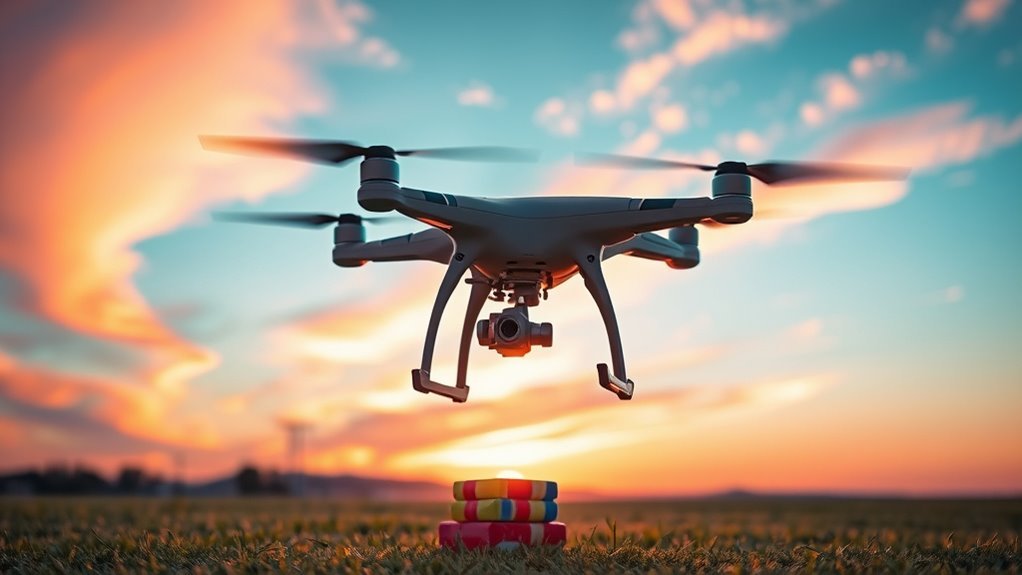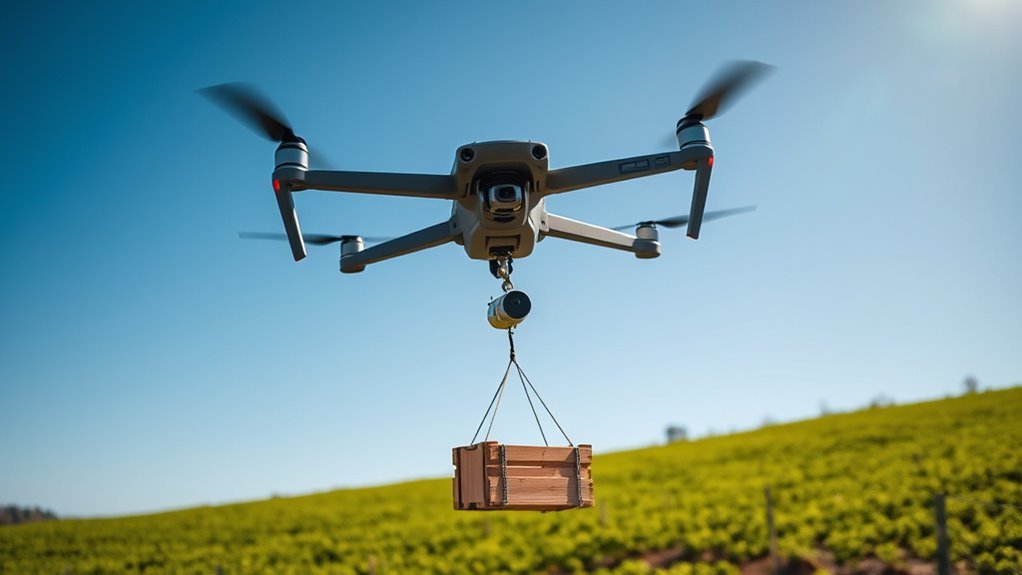You’ll find drone lifting capacities vary widely based on design, motor power, and purpose. Consumer drones typically lift between 200 grams and 2 kilograms, while commercial models can handle several kilograms to over 100 kilograms. Industrial heavy-lift drones and specialized military UAVs push payloads from tens of kilograms up to several tons. Load balance, motor torque, and battery life critically affect stable flight under weight. Understanding these factors highlights innovations expanding drone capabilities for diverse applications ahead.
Factors Affecting Drone Lifting Capacity

Although the maximum lifting capacity of a drone is often specified by manufacturers, several factors can considerably influence its actual payload capability in real-world conditions. When evaluating drone design, you must consider frame weight, motor power, and propeller efficiency, as these directly affect lifting mechanisms. The interplay between motor torque and propeller thrust determines how much weight the drone can sustain while maintaining stable flight. Additionally, battery capacity impacts endurance under load, limiting how long you can carry heavy payloads. Environmental factors like wind and altitude further challenge lifting performance, demanding robust design solutions. Understanding these variables empowers you to optimize or select drones that truly meet your freedom-driven needs for payload delivery without compromising flight stability or safety.
Types of Drones and Their Payload Limits

When evaluating drone payload capacities, you’ll find that different types are engineered for varying lifting capabilities tailored to specific applications. Racing drones, built with lightweight drone materials like carbon fiber, prioritize speed over payload, typically lifting under 500 grams. Photography drones balance weight and strength, using advanced lifting mechanisms such as multi-rotor configurations to carry cameras weighing one to three kilograms. Industrial drones, designed with reinforced frames and powerful motors, exploit robust lifting mechanisms and durable materials to handle payloads exceeding 20 kilograms. Heavy-lift drones often incorporate redundant systems to maintain stability under significant loads. Understanding these distinctions allows you to select a drone that matches your freedom to carry specific equipment, ensuring peak performance without compromising flight dynamics or safety.
Consumer Drones: Typical Weight Capacities

When evaluating consumer drones, you’ll find their average payload capacity typically ranges between 200 to 500 grams. Models like the DJI Mavic Air 2 and the Parrot Anafi illustrate these limits with precise engineering optimized for lightweight accessories. Understanding these capacities helps you select a drone that matches your specific lifting requirements without compromising flight stability.
Average Payload Limits
Most consumer drones typically handle payloads ranging from 200 grams to 2 kilograms, depending on their design and intended use. When evaluating payload capacity, you’ll want to examine the drone specifications closely, focusing on motor strength, battery life, and frame durability. These factors collectively dictate how much additional weight your drone can lift without compromising stability or flight time. Keep in mind that exceeding the recommended payload limits can reduce maneuverability and increase power consumption, limiting your operational freedom. Understanding average payload limits helps you select a drone that balances performance with your specific needs, whether it’s carrying a camera or other equipment. Ultimately, precise knowledge of payload capacity lets you optimize your drone’s utility while maintaining safe, reliable flight.
Common Consumer Models
Understanding average payload limits sets the stage for examining specific consumer drone models and their typical weight capacities. When choosing a drone, you’ll want to analyze drone features and lifting technologies carefully, as these determine how much weight your drone can handle without compromising flight performance. Below is a comparison of popular consumer drones highlighting their payload capacities:
| Drone Model | Max Payload (kg) | Key Lifting Technologies |
|---|---|---|
| DJI Mavic Air 2 | 0.3 | Efficient brushless motors, lightweight frame |
| Autel EVO Lite+ | 0.35 | Advanced ESCs, aerodynamic design |
| Parrot Anafi USA | 0.5 | Reinforced arms, high-torque motors |
Choosing the right model guarantees you maximize freedom in your drone’s operational capacity.
Commercial Drones Designed for Heavy Lifting
When evaluating commercial drones built for heavy lifting, you need to take into account their payload capacities, which often range from several kilograms to over 100 kg. Models like the DJI Matrice 600 and Griff Aviation’s heavy-lift drones exemplify this category with optimized thrust-to-weight ratios and robust frame designs. Understanding these specifications helps you select the right drone for industrial applications requiring substantial lift capabilities.
Payload Capacities Explained
Although commercial drones vary widely in design and purpose, those engineered for heavy lifting are distinguished by their enhanced payload capacities, often exceeding several kilograms. When you evaluate these drones, understanding payload optimization is essential—it guarantees the drone’s lifting mechanisms operate efficiently without compromising flight stability or battery life. Advanced lifting mechanisms, such as multi-rotor configurations and reinforced frames, distribute weight evenly and increase thrust. This balance allows you to maximize payload while maintaining control and maneuverability. In addition, precise calibration of motors and propellers further refines lifting performance. By focusing on these technical aspects, you gain insight into how these drones manage heavy loads, enabling you to select models that truly empower your need for freedom in transporting substantial cargo with reliability and precision.
Key Heavy-Lift Models
To maximize payload capabilities, manufacturers have engineered specific heavy-lift drones that integrate advanced multi-rotor systems, high-torque motors, and reinforced structural components. These models exemplify cutting-edge heavy lift technology and drone engineering, granting you the freedom to transport substantial loads efficiently.
| Model | Max Payload (kg) |
|---|---|
| DJI Matrice 600 Pro | 6 |
| Freefly Alta 8 | 9 |
| Griff 300 | 225 |
| Vulcan UAV Raven | 100 |
Each drone is optimized for different industrial tasks—from aerial cinematography to logistics. When selecting a heavy-lift drone, consider payload capacity alongside flight time and stability, ensuring your mission’s success without compromise.
Military Drones and Their Load Capabilities
Military drones can carry payloads ranging from a few kilograms to several tons, depending on their design and intended mission. When you analyze military applications, payload capacity directly influences operational flexibility—whether transporting surveillance equipment or deploying munitions. Understanding drone specifications such as motor power, frame strength, and lift efficiency is crucial to grasp these capabilities. You’ll find that smaller tactical drones prioritize maneuverability with limited payloads, while larger unmanned aerial vehicles (UAVs) are engineered to handle heavier loads, including weaponry and supplies. For those valuing freedom in operational reach and efficiency, selecting drones based on precise load requirements guarantees mission success without compromise. Ultimately, military drones balance payload capacity with endurance and stealth to meet diverse strategic objectives.
How Drone Design Influences Payload
When evaluating a drone’s payload capacity, you need to take into account how its design elements—such as frame structure, motor type, and propeller size—affect lift and stability. Efficient drone aerodynamics reduce drag, allowing you to maximize payload without compromising flight time. Material selection plays an essential role; lightweight composites like carbon fiber increase structural integrity while minimizing weight, directly enhancing lift potential. The motor’s torque and power output must match propeller dimensions to generate sufficient thrust, maintaining control under load. Additionally, the frame geometry influences airflow and balance, which are critical for stable maneuvering when carrying heavy payloads. By optimizing these design factors, you gain the freedom to extend operational capabilities, pushing the limits of what your drone can safely and effectively lift.
Safety Considerations When Carrying Loads
Carrying even a single additional kilogram markedly impacts your drone’s flight dynamics and safety margins. You must prioritize load security to prevent shifts that could destabilize flight or cause sudden drops. Ensuring the load is rigidly fastened reduces the risk of in-flight detachment and damage. Weight distribution is equally critical; uneven loads can create torque imbalances, increasing power consumption and diminishing control responsiveness. You should assess the center of gravity carefully, adjusting placement to maintain stability. Overloading beyond manufacturer specifications risks motor overheating and battery depletion, potentially leading to catastrophic failure. By rigorously evaluating load security and weight distribution before each flight, you preserve your drone’s maneuverability and operational freedom, ensuring safe, effective payload transport without compromising performance or safety.
Innovations Increasing Drone Payloads
Advancements in materials science and propulsion technology have considerably expanded the payload capacities of modern drones. When you leverage lightweight composites and high-strength alloys, drone frames become both durable and weight-efficient, directly boosting payload capability. Simultaneously, improvements in motor efficiency and battery energy density enable drones to sustain heavier loads longer without sacrificing agility. You’ll notice that drone technology now integrates sophisticated flight control algorithms, optimizing power distribution and stability under variable payload weights. These payload advancements allow you greater operational freedom, enabling complex missions previously limited by weight constraints. By focusing on modular designs and scalable propulsion systems, manufacturers give you flexibility to customize drones for specific lifting requirements, pushing the boundaries of what personal and commercial drones can carry. This precise engineering evolution is key to expanding drone functionality beyond traditional limits.
Practical Applications of Heavy-Lift Drones
With increased payload capacities achieved through innovative materials and propulsion systems, heavy-lift drones have become viable tools across various industries. You can leverage these advancements in heavy lift applications to enhance efficiency and operational reach. In drone logistics, they redefine cargo transport by enabling rapid, flexible delivery solutions. Key practical uses include:
- Industrial inspection and maintenance: transporting tools and equipment to hard-to-reach locations.
- Emergency response: delivering medical supplies or relief materials swiftly during crises.
- Construction and agriculture: carrying heavy components or spraying large areas with precision.

